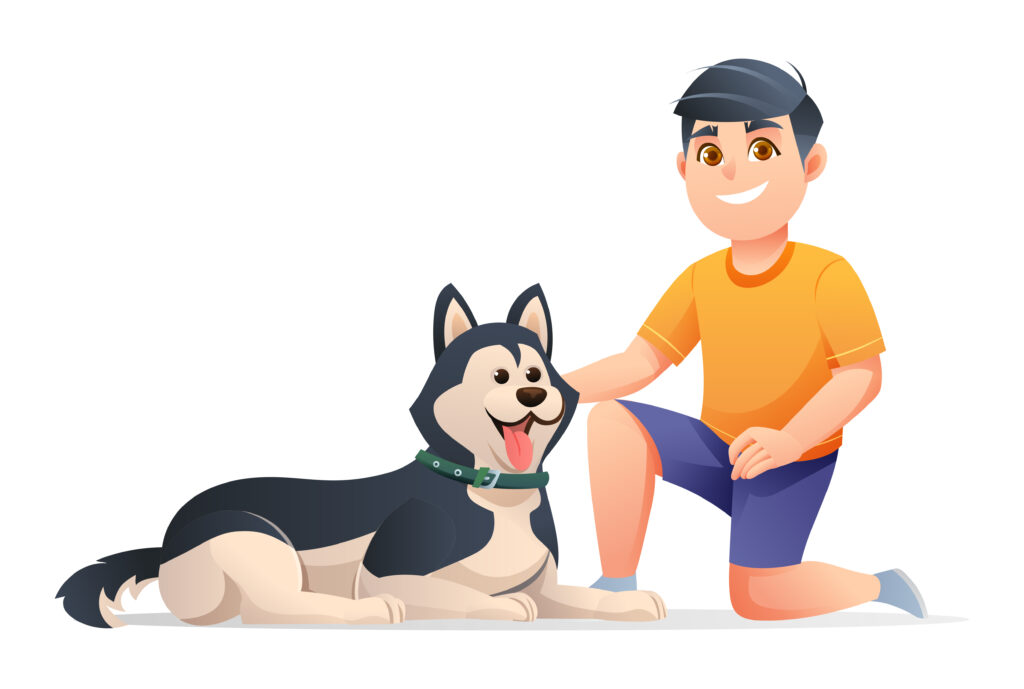Hey there, fellow dog lovers! If you’ve ever wondered how to teach your furry companion to shake paws or perform impressive dog tricks, you’ve come to the right place! Whether your pooch is a playful puppy or a seasoned senior, dog training can be a rewarding experience for both of you. In this article, we’ll delve into the world of dog training, specifically focusing on how to teach your dog to shake paws and perform various paw-related tricks. So, put on your best doggy face, and let’s dive right in!
The Power of Dog Training
Setting the Foundations
Before we dig into teaching your dog to shake paws, let’s lay the groundwork for successful dog training. Building a strong bond with your four-legged friend is crucial. Spend quality time together, engage in interactive play, and use positive reinforcement techniques, like treats and praise, to encourage good behavior.
Understanding Canine Body Language
A critical aspect of dog training is understanding your furry friend’s body language. Dogs communicate through subtle cues, and recognizing these signals will help you gauge their comfort levels and responses during training sessions.
Step-by-Step Guide to Teaching “Dog to Shake Paws” with Treats
1. Create a Positive Environment
The first step in training any new trick is to create a positive and comfortable environment for your dog. Choose a quiet space with minimal distractions, as this will help your pet focus better during the training sessions.
2. Introduce the Concept
To begin the training, use a treat to get your dog’s attention. Once your dog is focused, hold the treat in your closed fist near their paw. The curiosity will lead them to paw at your hand. As soon as they make contact with your hand, use a clicker or verbal praise like “good” and reward them with the treat.

3. Incorporate Verbal cues
Now, introduce a verbal cue like “shake” or “paw.” Use this cue every time you present your closed fist. Repetition is key to reinforcing the association between the cue and the action.
4. Encourage Paw Placement
Gradually, as your dog becomes familiar with the verbal cue, encourage them to place their paw directly on your open palm instead of pawing at your closed fist. Use the verbal cue and reward them with a treat when they successfully place their paw in your hand.
5. Add Distractions
As your dog becomes proficient at shaking paws, start introducing mild distractions during the training sessions. This will help them master the trick even in more challenging environments.
6. Gradually Reduce Treats
While training, it’s natural to use treats as rewards. However, as your dog becomes more adept at shaking paws, gradually reduce the frequency of treats. Instead, offer verbal praise and physical affection as rewards.

7. Celebrate Success
Once your dog masters the “shake paws” trick, don’t forget to celebrate the achievement! Show off their new skill to friends and family, and continue practicing to maintain the learned behavior.
Guide to Teaching “Shake or Paws” without Treating
One of the most endearing and impressive tricks is teaching your dog to shake its paws. While treats are commonly used as rewards during training, there are alternative methods to achieve this goal without relying solely on treats. Let’s walk through effective, treat-free techniques to teach your dog to shake paws like a true professional!
1. Understand Your Dog’s Personality
Every dog is unique, and understanding your dog’s personality is crucial for successful training. Some dogs are highly motivated by treats, while others respond better to praise or physical affection. Observe your dog’s reactions during various interactions to identify what rewards they enjoy the most. This will help you tailor your training approach accordingly.
2. Establish Clear Communication
Dogs respond well to consistent and clear communication. Use simple verbal commands, such as “Shake” or “Paw,” to associate them with the action you want your dog to perform. Pair these commands with clear hand gestures or signals to reinforce understanding. Use positive, encouraging tones during training to make your dog feel comfortable and motivated.
3. Create a Positive Training Environment
Choose a quiet and distraction-free area for training sessions. A calm environment will help your dog focus and grasp training concepts faster. Eliminate any potential sources of fear or discomfort, ensuring that your dog associates the training sessions with positive experiences.

4. Use Clicker Training
Clicker training is an effective method that replaces treats with the sound of a clicker as a reward signal. Start by clicking the clicker whenever your dog performs a desirable action, such as lifting their paw. Follow the click with praise or a gentle pat. Over time, your dog will associate the click with a positive response and be motivated to repeat the action.
5. Offer Verbal Praise and Affection
Verbal praise and physical affection are powerful tools for teaching your dog to shake paws without treats. When your dog responds correctly to the “Shake” command, shower them with enthusiastic praise and gentle petting. Dogs thrive on positive reinforcement and will be eager to please you to receive more affection.
6. Utilize Favorite Toys
Incorporate your dog’s favorite toys into the training process. Whenever your dog offers their paw to shake, reward them with playtime and interaction with their beloved toy. Associating the action with play will make your dog more enthusiastic about shaking paws without expecting treats.
7. Practice Patience and Consistency
Training a dog takes time, patience, and consistency. Dedicate short, frequent sessions to teaching your dog to shake its paw. Repetition and reinforcement are essential for your dog to grasp the concept. Celebrate every small progress, and remember that consistency will lead to long-term success.
8. Involve Family Members and Friends
Incorporating other family members or friends into the training process can be beneficial. This way, your dog will learn to generalize the behavior and perform the trick for various people, not just you. It also adds excitement and variety to the training sessions.
9. Avoid Punishments
Avoid using punishment or scolding if your dog doesn’t immediately pick up the trick. Negative reactions can create anxiety and hinder the learning process. Stay patient, and remember that each dog learns at their own pace.
10. Celebrate Achievements
As your dog begins to shake paws without treats consistently, celebrate their achievements. Host a mini “paw-shaking party” where they receive extra attention, playtime, and maybe even a new toy. Positive reinforcement for their efforts will reinforce their behavior and strengthen the bond between you and your furry companion.
These general tips will help you get started:
Positive Reinforcement: Use treats, praise, or affection to reward your dog for good behavior. This will encourage them to repeat the desired actions.
Be consistent. Consistency is crucial in dog training. Use the same commands and gestures each time you want your dog to perform a particular action.
Short Sessions: Keep training sessions short and frequent. Dogs have shorter attention spans, so 5–10 minutes of focused training at a time is more effective than long, extended sessions.
Patience and Positive Attitude: Stay patient and maintain a positive attitude during training. Dogs respond better to encouragement than punishment.
Avoid Punishment: Avoid physical punishment or yelling. It can create fear and anxiety in your dog, which may lead to behavioral issues.
Socialization: Expose your dog to different environments, people, and other animals to improve their social skills and reduce anxiety.
Set Boundaries: Establish clear rules and boundaries to prevent your dog from engaging in undesirable behaviors.
Leveling Up: Advanced Paw Tricks
High-Five
Elevate the paw-shaking game with a high-five trick. Instead of tapping the paw, raise your hand, and your clever canine will learn to meet your palm with their paw.
Double Shake
Impress your friends with a double shake! After teaching your dog to shake paws, encourage them to switch and offer the other paw when prompted.
What to do when the dog seems uninterested in shaking paws?

If your dog doesn’t want to shake paws, don’t worry! Here are some simple steps you can try to make it more enjoyable for your furry friend:
- Patience and Calmness: Stay patient and calm when teaching your dog to shake paws. They might need some time to feel comfortable with the idea.
- Tasty Treats: Use yummy treats your dog loves as a reward. Hold the treat tight in your hand by making a fist and then, let your dog sniff it.
- Touching Paws: Gently touch your dog’s paw while giving it a treat. Do this a few times, so they get used to the feeling.
- Praise and Encouragement: Whenever your dog shows interest in their paw or tries to lift it, give them lots of praise and encouragement.
- Repetition: Practice regularly for short periods, maybe a few minutes a day. Consistency will help your dog learn.
- Positive Association: Make it a fun game! Use a happy tone of voice and add a playful element to the process.
- No Force: Never force your dog to shake its paws. It should be a voluntary action, not something they feel pressured to do.
- Stay Patient: Every dog is different, so it might take some time. Keep practicing, and eventually, they might start shaking paws with you.
Remember, not all dogs enjoy shaking paws, and that’s perfectly okay. Some dogs prefer other ways of showing affection.
What to do when your dog lifts both paws instead of just one?
If your dog offers both paws instead of one, you can follow these steps:
- Stay calm: Avoid scolding or punishing your dog for the mistake.
- Choose the paw: When your dog raises both paws, gently take one paw in your hand while keeping the other on the ground.
- Repeat the command: Say “Shake” while holding the chosen paw, and reward your dog for the correct response.
- Practice: Continue practicing the command, focusing on one paw at a time, until your dog consistently offers the correct paw when prompted.
Conclusion
Congratulations, pet parents! You’ve embarked on a thrilling journey of dog training and learned how to teach your canine companion to shake paws like a pro. Remember, the key to successful training is consistency, patience, and, most importantly, bonding with your dog. So, unleash the potential of your four-legged friend and keep exploring the limitless possibilities of dog tricks. Happy training and wagging tails!
Frequently Asked Questions
Q: Is it too late to teach an old dog new tricks?
Not at all! Dogs of any age can learn new tricks with patience and consistent training
Q: How long does it usually take to teach a dog to shake paws?
The timeframe varies, but with daily short sessions, some dogs can learn in a week, while others may take a few weeks.
Q: Can I use toys instead of treats for training?
Absolutely! Toys can be equally rewarding and effective during dog training sessions.
Q: My dog is shy and reluctant to give a paw. What should I do?
Be patient and gentle. Use positive reinforcement to create a safe environment for your dog to build confidence.
Q: Are there any tricks to teach my dog after mastering paw-shaking?
Certainly! You can explore various tricks like rolling over, playing dead, or even dancing together.
Q. How long will it take for my dog to learn to shake paws?
The time it takes for your dog to learn the “shake paw” command can vary depending on the individual dog. Some dogs may pick it up quickly within a few days, while others may take several weeks. Consistent training, positive reinforcement, and patience are keys to successful learning. Remember that every dog is unique, and some may take longer to master the skill.



